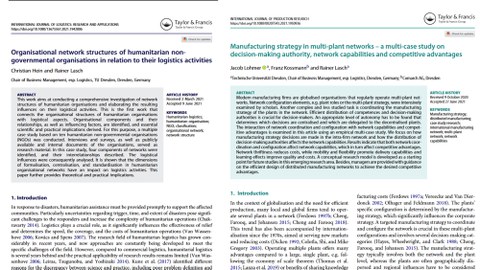Jul 20, 2021
Neue Publikationen zu Netzwerkstrukturen in der Logistik
Die Professur freut sich über zwei neue Artikelveröffentlichungen.
Im Beitrag von Christian Hein und Prof. Dr. Rainer Lasch werden Netzwerkstrukturen humanitärer Organisationen untersucht und die daraus resultierenden Einflüsse auf deren logistische Aktivitäten herausgearbeitet.
In dem zweiten Beitrag von Jacob Lohmer, Franz Kossmann und Prof. Dr. Rainer Lasch wird eine empirische Analyse der Entscheidungsstrukturen und des Autonomiegrades in Bezug auf die Fertigungsstrategie von Fertigungsnetzwerken durchgeführt und ein Forschungsframework abgeleitet.
-----------------------------------------------------------------------------------------------------------------------
Christian Hein & Rainer Lasch (2021): Organisational network structures of humanitarian non-governmental organisations in relation to their logistics activities, In: International Journal of Logistics Research and Applications, DOI: 10.1080/13675567.2021.1942806
Abstract. This work aims at conducting a comprehensive investigation of network structures of humanitarian organisations and elaborating the resulting influences on their logistical activities. This is the first work that connects the organisational structures of humanitarian organisations with logistical aspects. Organisational components and their relationships, as well as influencing factors, are identified, and essential scientific and practical implications derived. For this purpose, a multiple case study based on ten humanitarian non-governmental organisations (NGOs) was conducted. Interviews and surveys, as well as publicly available and internal documents of the organisations, served as research material. In this case study, four components of networks were identified, and their interrelationships described. The logistical influences were consequently analysed. It is shown that the dimensions of formalisation, centralisation, and standardisation in humanitarian organisational networks have an impact on logistics activities. This paper further provides theoretical and practical implications.
Keywords. Humanitarian logistics, humanitarian organisation, NGO, classification, organisational network, network structure
------------------------------------------------------------------------------------------------------------------------
Jacob Lohmer, Franz Kossmann & Rainer Lasch (2021): Manufacturing strategy in multi-plant networks – a multi-case study on decision-making authority, network capabilities and competitive advantages, In: International Journal of Production Research, DOI: 10.1080/00207543.2021.1950936
Abstract. Modern manufacturing firms are globalised organisations that regularly operate multi-plant networks. Network configuration elements, e.g. plant roles or the multi-plant strategy, were intensively examined by scholars. Another complex and less studied task is coordinating the manufacturing strategy of the plants in the network. Efficient distribution of competences and decision-making authorities is crucial for decision-makers. An appropriate level of autonomy has to be found that determines which decisions are centralised and which are delegated to the decentralised plants. The interaction of network coordination and configuration with network capabilities and competitive advantages is examined in this article using an empirical multi-case study. We focus on how manufacturing strategy decisions are made in the intra-firm network and how the distribution of decision-making authorities affects the network capabilities. Results indicate that both network coordination and configuration affect network capabilities, which in turn affect competitive advantages. Network thriftiness reduces costs, while mobility and flexibility promote delivery capabilities and learning effects improve quality and costs. A conceptual research model is developed as a starting point for future studies in this emerging research area. Besides, managers are provided with guidance on the efficient design of distributed manufacturing networks to achieve the desired competitive advantages.
Keywords. Manufacturing strategy, distributed manufacturing, case study research, international manufacturing network, multi-plant network, network capabilities
